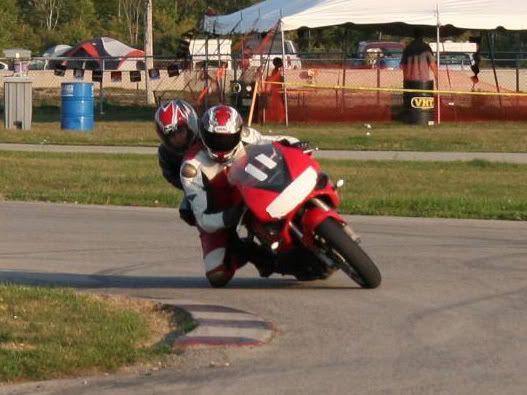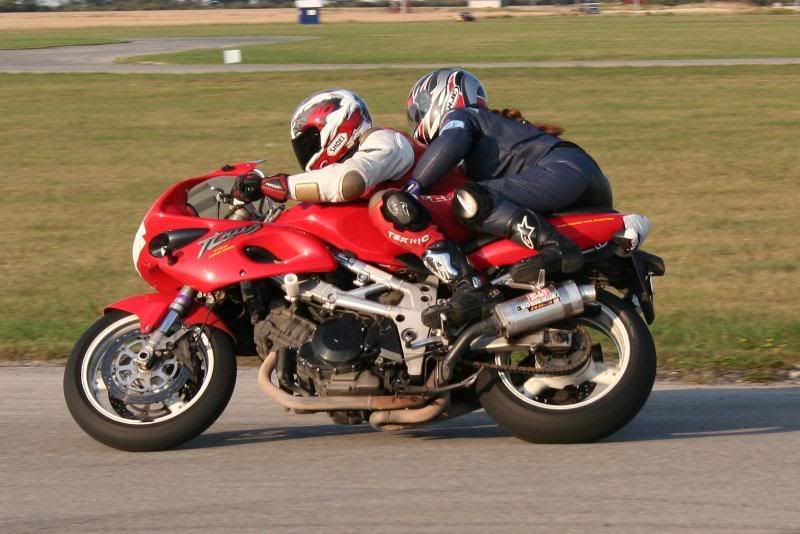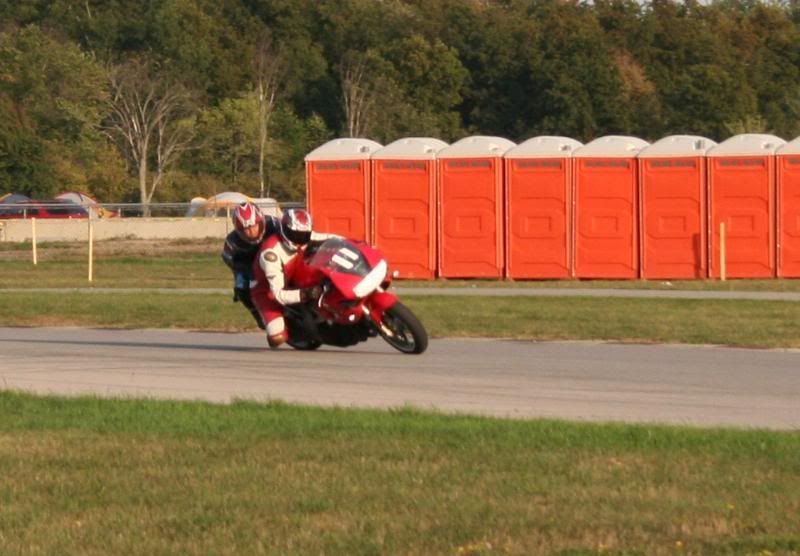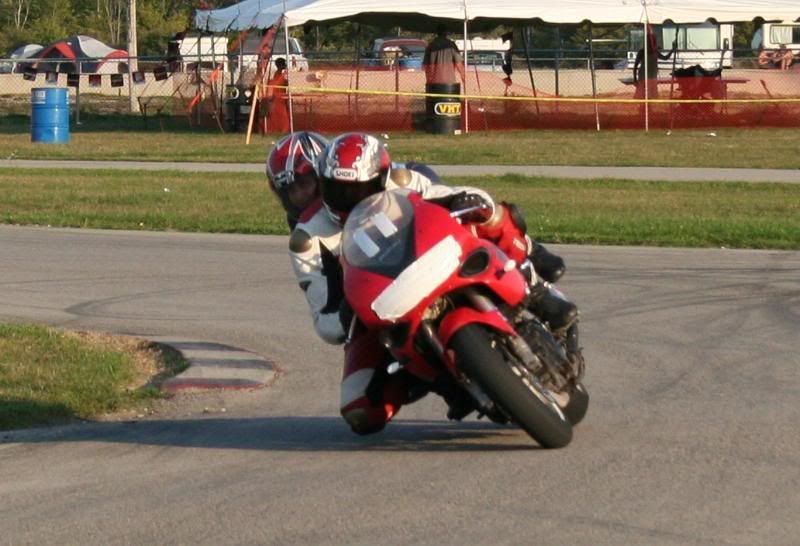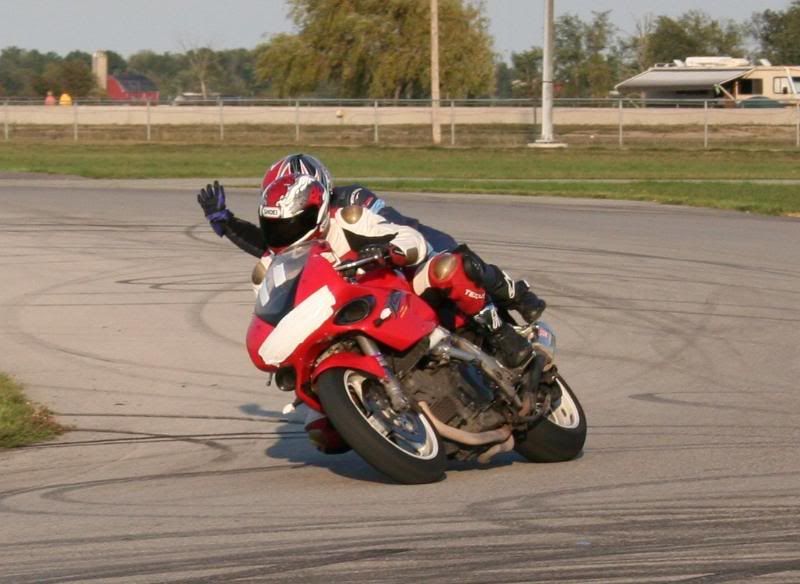I don't remember where I got this from, but here it is:
How to Be a Motorcycle Passenger
When you climb on the back of a motorcycle, you are literally putting your life in the rider's hands. Here's what you should know and consider before taking that step.
By Art Friedman.
 WEB EXCLUSIVE.
WEB EXCLUSIVE. Learning how to ride a motorcycle is tricky, but learning how to ride as a passenger is ever harder. There aren't any schools for it (though some rider-training classes are set up for riders with passengers). In most cases, the only person who you can ask for advice is the rider (i.e., the driver), who may never have done it, and may be the biggest issue you encounter. We decided to run this story on our website instead of in the magazine, because we believed that would make it available to more prospective passengers in time to be of some assistance.
What to Expect
If you are going to accept a motorcyclist's invitation to ride along behind him or her, you should expect that person to have some experience both riding motorcycles and carrying passengers. You should expect the rider to make sure you have protective gear and are using it properly. The rider should explain how to mount, sit on, and dismount the motorcycle, what to do when you corner, brake and stop, and how to communicate essentials like "stop," "slow down," or "I have a problem." The person you are entrusting your safety to should display a concern for your welfare and enjoyment of the ride.
Let's examine each of those points in detail, so you know what to expect.
Rider Experience

Riding with a passenger requires a bit more skill than riding solo. The bike is heavier and won't steer as nimbly or brake in as short a distance. It will be more difficult to balance at a stop. A new rider won't have experience, and these issues may present a challenge to him. So you first question, when invited to ride with someone, should be "How long have you been riding?" If it was my daughter, the answer would have to be at least a year.
Other questions I'd follow-up with are:
"How long have you been riding this bike?" I'd like to hear at least three months.
"How did you learn to ride?" If he has been riding for years or graduated from a dirt bike, those are both acceptable answers. But for a recent rider, I'd want to hear that he took a state or < a href="
http://www.msf-usa.org/">Motorcycle Safety Foundation (MSF) rider-training course.
"How much riding have you done with passengers?" If he needs to practice, tell him to practice with his mom.
"Do you have a motorcycle endorsement on your license?" This is a very important. A rider who has not obtained a motorcycle endorsement on his driver's license is either not serious about motorcycling or doesn't believe he's skilled enough to pass the simple rider's test. Riders without motorcycle licenses are way over-represented in the accident statistics. I'd even ask to see it. No endorsement, no go.

"Are you insured?" This is a simple test of responsibility and attitude. If he is serious about it, he'll have insurance, though it probably won't cover you.
"Had any crashes?" Besides the fact that his crash demonstrates a past problem, riders who crash often have crashed in the recent past.
"Do you ever drink and ride?" If he says, "Well. If I've just had one beer..." I'd say "Uh-oh."
Next, I'd find out what he proposes for your first ride. If it is a day-long ride somewhere, I'd suggest a one or two shorter rides first on the same motorcycle. You will want a short ride to see if you feel comfortable with his riding and the motorcycle itself.
There should be some conditions established for this first ride or two. The rider should agree to end the ride on your terms--turn around and go back, or wait while you are picked up by a friend or a taxi. If you are frightened by the experience, for whatever reason, this provides you a ready out.
Riding Gear

Ask about what riding gear you'll be provided or have to supply. At the minimum, you will need a helmet that meets the DOT (Department of Transportation) standard, and the rider should automatically expect that you will wear one. No matter whether it's required by law, if something goes wrong, it is all that stands between you and death or life as something akin to a fungus. If the rider tells you that he doesn't wear one, I'd view that as a sign that he has not really considered the risks of motorcycling or simply has not paid attention to the realities and risks of motorcycling. His attitude is either dangerous or unrealistic. I wouldn't ride with him or let my family ride with him.
Helmet fit is a tricky issue with a passenger. A rider isn't likely to buy a helmet to fit you on the first ride. However, a helmet that is too small can be uncomfortable or even painful. One that is too big can come off in mid-crash. I'd find it acceptable if the fit is a bit sloppy but it passes the roll-off test. That test goes like this. Fasten the chin strap snugly, then grab the rear of the helmet, pull up and forward forcefully and try to roll it forward and off over your chin. If it comes off, it fails, and you need a different (and probably smaller) helmet. For detailed information on helmet fit and selection, see our
helmet-buying story.

Some passengers balk when a rider presents them with a full-coverage helmet--one that has a section over the mouth with an eyeport covered by the face shield. They shouldn't; the rider has spent more money to get them superior protection. In most cases, this sort of helmet also includes good eye-protection, but if there is no faceshield, you should wear glasses or goggles.
A helmet really is essential. It will protect you from a real life-destroying event. Someone who tells you otherwise is either misinformed or being dishonest. The rest of the recommended riding gear will most likely just prevent pain and suffering. You should wear long pants. Even a minor tip-over can leave uncovered legs scarred for life. Jeans do an acceptable job of protection, though heavier clothing is better. Don't ride in shorts or accept a ride from a rider who does (who once again has failed the test about whether he has realistically assessed the risks).
If you don't have gloves, the rider should supply some. Even a pair of heavy leather work gloves will suffice if they fit properly. A snug fit is important, so they don't come off if things go wrong. Fingerless gloves are another sign of thoughtlessness. Gloves should cover your entire hand.
Motorcycle jackets offer features designed to make them more comfortable while riding and to provide better protection in a fall, but if one isn't available, a jacket made of solid textile is better than nothing. A denim jacket is better than a garment made of lightweight fabric.
Real motorcycle boots are nice, but any solid shoe that covers your foot and ankle will give useful protection. If you don't have shoes that come over your ankle, then choose solid shoes that completely cover your feet. Make sure any laces won't get blown loose and flap where they could get caught in the rear wheel or drive belt or chain, which could injure you or cause a crash.
Before You Ride

If you have never or rarely ridden before, the rider should go through a number of details with you. He should show you how to get on and off the motorcycle. This should include whether he wants you to get on first (usually not, but more common on big bikes with passenger backrests), whether he expects you use the passenger peg as a step or simply throw your leg over the seat (let him know if you can't do this), which side you will approach from, whether you can use his shoulders or arm to steady yourself, and most importantly, how to confirm that he is ready for you to mount. If you catch him by surprise, you could cause the bike to fall over. When the ride is over, will you get off first or will he? Which side and will you use the footrest as a step? He should warn you about any hot parts, normally the exhaust system, to avoid touching.

He should show you where to put your feet while riding, which should be on your own footrests. If they can fold up, he should demonstrate this and make sure they are folded down. He should warn you to keep your feet clear of the wheel and drive system, even though problems are rare. At a stop, he should be able to support the bike without your help, so he should tell you to keep your feet on the pegs when stopped. If he can't do this, I'd be reluctant to ride with him. You should warn him if you want to put your foot down at a stop.
You should establish what you will hold on to. This will not be much of an issue on a motorcycle with a large passenger backrest, but on other bikes you should hold on to the rider at the waist with at least one hand. If there is a large grab rail around your seat, you can hold onto this with your second hand if it's comfortable to so. Otherwise hold onto the rider's waist with both hands. There are belts available with handholds to make this easier, though they are rare. Do not hold on to his shoulders or arms, which can interfere with control, and do not bother trying to use any strap attached to the seat, which provides an unsteady anchor and will affect the motorcycle's stability.
Leaning for Corners

The rider should explain what he wants you to do when leaning into corners. Your body position will influence steering and lean angle, so what you do will affect the rider's control of the bike. I normally tell the passenger to stay neutral--that is, to lean neither with or against the motorcycle--and to look over my inside shoulder. It is important to not shift your weight suddenly in the corner. You should also know that if you are uncomfortable about how far the bike is leaning, that leaning out of the corner and trying to straighten the motorcycle up will probably have just the opposite effect. The rider will have to lean the motorcycle even deeper into the corner to maintain his arc.
On some bikes, such as the big wide cruisers, some parts will drag rather easily in corners. The rider should inform you of this and perhaps even demonstrate in a parking lot. He should also be sufficiently familiar with his bike that he can warn you when it's about to happen for the first time. Though it may make an alarming noise, particularly if you aren't ready for it, but it doesn't actually signal anything dangerous.
Braking and Acceleration

During heavy braking, you may be pressed against the rider. If you have a grab rail and can take up some of the pressure, that's fine, but the rider, who has an easier time of supporting himself, should be able to support your weight against him, even under very heavy braking. You may want to hold yourself off the rider's back with your hands of simply lean into his back. Some riders (usually male) with passengers (usually female) who are trying for cheap intimacy may brake harder or more frequently than they need to. This practice is known as the "boob jam," and if you feel you are being subjected to it, feel free to confront him.
Motorcycles can accelerate more forcefully than cars, which may cause problems if there is no passenger backrest. It may not be possible to get a firm handhold on the rider for a variety of reasons, and you can hold on only so tight by gripping with your legs. If this is a concern, be sure you tell the rider about it so he accelerates more gently or provides a secure hold point. He should also transition from steady speed or slowing to acceleration somewhat gradually, so you have time to react. However, you should pay attention to the traffic situation too, so you can anticipate what might happen.
It's not uncommon for your helmets to bump when accelerating or decelerating. Don't apologize. This is not causing a problem, and it's normally the rider's fault because he isn't riding as smoothly as he should.
Communication and the First Ride
Before you leave on a ride that's longer than around the block, you should set a few basic signals to communicate your needs. One tap on the right shoulder, for example, might mean "I want to stop when it's convenient." Two might mean, "It's kind of urgent." And three means, "Stop right now!" A tap on the left shoulder might mean "Look at this" or what you are pointing at. Tapping both might mean "I have a problem." A thumbs-up means "I'm having fun," thumbs down the opposite, and sideways means the jury is out. You may be able to communicate vocally at low speeds or when stopped but the wind will probably prevent it at speed. A patting motion in front of the rider might mean "Please slow down."

You should plan to stop a few minutes into that first ride to discuss things and every 20 or 30 minutes thereafter. You should also have established how long and far the ride is going to be.
As I mentioned before, the first ride should be short with a provision to opt out of any further riding if you don't like it. It should also be just your motorcycle, since riding in a group of motorcycles puts pressure on rider to do what the rest are. Other riders and bikes also create distractions. Ideally it should be where there isn't much traffic, though a stint at highway speeds is probably a good idea if you are contemplating longer rides in the future.
You should assert yourself any time you aren't comfortable or enjoying the experience, even before you get on. If the rider or the bike make you feel uncomfortable, it's best to stop things before they get worse.
The Motorcycle
A woman recently told me about being invited to ride on a motorcycle for the first time and being surprised that there was no backrest for the passenger "or anything to keep you from sliding off the back." I suspect it was more of an issue because she didn't want to hold onto the person who invited her to ride.

Certainly there are aspects of a motorcycle that can make it more suitable or pleasant for a passenger or make it unpleasant or even unsafe. Backrests are the most desired feature for a passenger, and the bigger the better. However, only a minority of motorcycles come with any passenger backrest at all, so don't expect one. Normally the biggest passenger backrests are those that are part of a trunk assembly, which may include armrests and speakers (with controls for the stereo). However, there are setups, like those from Custom World International (
www.cw-intl.com), for cruisers that offer the same large backrest and arm supports. These permit the passenger to relax and feel secure without holding onto the rider. Smaller backrest may simply provide a barrier to sliding off the seat and not actually be a place to rest your back.
The seat itself is the next most important item. The ideal saddle is deep and comfortable, wide enough to support you and roomy enough front to rear to give you room to adjust your position without crowding against the rider. A narrow seat is not only uncomfortable, but it makes you feel less secure. It should not slope rearward (as a few, such as that on the Harley V-Rod, do), and any slope to the front should be very small so that you don't tend to slide into the rider. Many cruisers and touring bikes provide a raised passenger saddle, which permits the passenger to easily see over the rider. The passenger's section of the saddle is something you should consider on any preliminary check-out ride. If you are developing a long-term riding relationship with somebody with an uncomfortable passenger seat, ask if it might be changed. Virtually any motorcycle can be equipped with a more comfortable accessory saddle or just a nicer passenger section.
Footrest position can be an issue, if it bends your legs in an uncomfortable way or doesn't allow you to support yourself on your legs (which can be important over bumps). Floorboards, wide flat plates that provide a roomier perch for your feet, offer more flexibility and are available for many cruisers and touring bikes.
Normally the rider will adjust the suspension to accommodate the added weight of a passenger, but even this will do little to improve a poorly calibrated suspension or one with limited travel. Motorcycles don't ride as smoothly as cars, for a variety of reasons, but some are plain bad. In some cases, the suspension can be improved with aftermarket parts. Vibration, on the other hand, is forever. If it buzzes uncomfortably, there is nothing to be done except get off, though the rider might be able to avoid operating the engine uncomfortable rpm if you mention it.
Any of these aspects of the motorcycle that concern you should be mentioned to the rider, who might be able to make an adjustment or at least change it before his next outing with a passenger.
Child passengers require special considerations addressed in
another article in the
Street Survival section of
MotorcycleCruiser.com
Further Adventures
If your early experiences as a motorcycle passenger make you want to do more, there are number of avenues you can pursue. If you'd like to learn to become a motorcycle rider yourself, the Motorcycle Safety Foundation can hook you up with one of the courses that have trained millions of riders in safe locations, with motorcycles supplied and professional, trained instructors. This is a
much safer and easier way to learn to ride than from a friend. You can get info and find a facility in your area in
MSF's rider-training section or by calling the MSF at (800) 446-9227. The MSF also offers an
off-road rider training course.

If you are planning on remaining a passenger, you and your rider may be able to find one of the courses that address this partnership.
If you plan to ride regularly, either as a rider or passenger, you will want to acquire your own gear. A comfortable helmet is the biggest item, in terms of cost, safety and comfort. You can find
advice on buying one in the "
Accessories and Gear section of MotorcycleCruiser.com. A jacket or full suit is the other major purchase, but gloves should be one of your first purchases too. If you ride frequently or travel on a motorcycle, you will also want a
rainsuit. One that is built for motorcycling will work better on a motorcycle and hold up longer than a generic style. If you ride frequently, you will want additional gear that lets you adapt to weather changes.
The biggest step to enjoying the back seat of a motorcycle is finding an experienced and thoughtful rider. With his or her help, you can address the safety and ergonomic issues and open up a new world that you never would have known in a car.
Art Friedman is the founding Editor of Motorcycle Cruiser
and past editor of Motorcyclist Magazine . He was also the Principal Investigator for the National Agenda for Motorcycle Safety . He occasionally rides as passenger but more often with one. If you have comments on this article, he would enjoy receiving email from you at Art.Friedman@primedia.com or at ArtoftheMotorcycle@hotmail.com .













